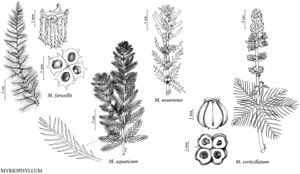Myriophyllum verticillatum
Sp. Pl. 2: 992. 1753.
Herbs monoecious, aquatic, sometimes forming dense stands. Stems branched or unbranched, to 3 m. Turions present, becoming brown to red-brown at maturity, clavate to obdeltoid, with abrupt transition from foliage leaves to reduced turion leaves, (6–)11–37(–52) × (3–)4–6(–9) mm, apex ± rounded, lateral turions with several whorls of minute, brown prophylls, entire proximallyand toothed to lobed distally, ovate to elliptic or lanceolate in outline; leaves pectinate, strongly appressed to axis throughout, narrowly flabelliform in outline, 4.5–7.5 × 1.2–1.8(–4) mm; segments 8–12(–18), flattened, linear-lanceolate, longest segment 1.5–6 mm, basal segment usually greater than or equal to 2/3 central axis of leaf, apex ± acute, trichomes usually absent. Leaves in whorls of (3 or)4, heteromorphic; petiole to 6 mm; submersed leaves pectinate, ovate to elliptic in outline, (7–)12–30(–46) × 9–24(–40) mm, segments (9–)12–22(–34), linear-filiform, longest segment (2–)6–19(–29) mm; emersed leaves pectinate, lanceolate to elliptic to ovate in outline, 2–5(–15) ×0.9–2.6 mm, segments (9–)12–20, greater than 0.5 mm. Inflorescences to 25 cm; flowers proximally pistillate, medially bisexual, distally staminate, in whorls of 4; bracteoles cream, ovate, 0.3–0.6(–1) × 0.1–0.6(–1.3) mm, margins deeply dissected into irregular lobes. Staminate flowers: sepals cream, narrowly triangular to deltate, 0.5–0.7(–0.9) × 0.4–0.6(–0.8) mm; petals persistent, cream, sometimes apically suffused with purple, elliptic to obovate, 1.8–2.2(–2.4) ×0.7–1.5 mm; stamens 8, filaments to 2 mm, anthers 0.8–1.7 × 0.3–0.6 mm. Pistillate flowers: sepals greenish to cream, elliptic to triangular, 0.2–0.7 × 0.2–0.7 mm; petals often caducous, sometimes persistent, cream to purple, elliptic to obovate, 0.4–0.7(–0.9) × 0.3–0.5(–0.8) mm; pistils (1.3–)1.8–2.7 mm, stigmas red to± purple, to 0.8 mm. Fruits globose, shallowly 4-lobed. Mericarps olive-green to brown, subglobose to globose, 2–2.7(–3) × (0.9–)1.1–1.3(–1.7) mm, transverselywidely obovate, abaxial surface broadly rounded to moderately flattened, smooth, often with 2 shallow longitudinal ridges, wings and ribs absent. 2n = 28.
Phenology: Flowering and fruiting Jul–Oct.
Habitat: Streams, rivers, ponds, lakes, sloughs, tannic waters.
Elevation: 0–2700 m.
Distribution
St. Pierre and Miquelon, Alta., B.C., Man., N.B., Nfld. and Labr., N.W.T., N.S., Nunavut, Ont., P.E.I., Que., Sask., Yukon, Alaska, Ariz., Calif., Colo., Conn., Del., Idaho, Ill., Ind., Iowa, Maine, Md., Mass., Mich., Minn., Mont., Nebr., Nev., N.H., N.J., N.Y., N.Dak., Ohio, Oreg., Pa., S.Dak., Tex., Utah, Vt., Wash., Wis., Wyo., Eurasia, nw Africa (Algeria, Morocco).
Discussion
Four varieties of Myriophyllum verticillatum have been proposed. Fassett based M. verticillatum var. cheneyi solely on the presence of four stamens. M. L. Fernald (1950) considered var. cheneyi conspecific with M. hippuroides. Some specimens labeled as var. cheneyi examined during this treatment were confirmed to represent M. hippuroides as noted by S. G. Aiken (1981). Fernald recognized vars. intermedium, pectinatum Wallroth, and pinnatifidum Wallroth based on differences in the length of floral bracts. All of these varieties can be found in the flora area though floral bract length is a very plastic character and there is no distinct separation among the forms. The presence and morphology of turions of M. verticillatum can be very helpful in the identification of vegetative material. The clavate to obdeltoid shape and reddish brown color of the turions in this species differ from the cylindrical, typically dark green turions of both M. farwellii and M. sibiricum.
Previous floristic studies have reported that the submersed leaves of Myriophyllum verticillatum have 18–34 segments. An examination of specimens unambiguously assignable to this species based on floral and fruit characters found the lower value of the range to be nine. The broad range for segment number and other leaf characters for M. verticillatum and overlap of these values with those for other Myriophyllum species underscores the importance of relying on floral and fruit characters for identifications.
Selected References
None.
